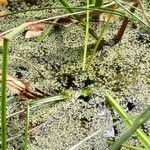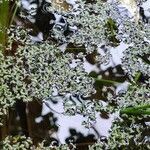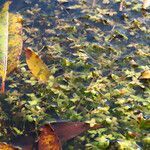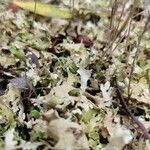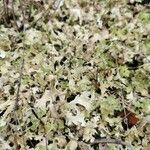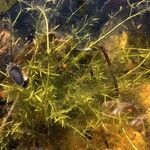Fronds (except when flowering or fruiting) submersed, 3-50 coherent in one group and often forming branched chains, attenuate at base into green connecting stalk 2-20 mm, green and subhyaline, sometimes purplish, narrowly ovate to elliptic, 3-15 mm (without stalk), 2-3.5 × as long as wide, flat, without papillae on upper surface, margin denticulate distally; veins 3, rarely 1, central vein approximating apex, lateral veins ca. 1/2 of frond length. Root 0.5-2.5 cm, often lacking, sheath not winged, apex mostly pointed. Turions absent. Flowering and fruiting fronds free floating on water surface, 1-5 coherent, 3-5 mm. Ovary with 1 ovule; utricular scale with narrow opening at apex. Fruit laterally winged toward apex. Seed with 12-18 distinct ribs. Fl. (rare) May-Sep. 2n = 20, 40, 42, 60, 63, 80.
Submerged aquatic.. Thalli thin, oblong-lanceolate, 5–10 mm. long, with a stipe almost as long again, 2–4 mm. wide, margin ± toothed in the upper third, entire and undulate below.. Daughter thallus budding in pouch situated in lower third, each remaining attached by stipe, thus forming a lattice.. Root, if present, solitary; cap acute.. Fertile thalli few, non-stipitate, much smaller than non-fertile thalli, free-floating at water-surface: flowering pouch produced near base of thallus.. Spathe present, enclosing 2 male and 1 female flower.. Staminate flowers protandrous, each with one curved stamen at different stages of development, making direct contact with style of another plant.. Pistillate flower with 1 ovule.. Seed oblong, ribbed.. Fig. 1/1.
Roots to 2.5 cm (sometimes not developed), tip pointed; sheath not winged. Green stalks 2--20 mm. Fronds submersed (except when flowering or fruiting), 3--50, coherent and very often forming branched chains, narrowly ovate, flat, thin, 3--15 mm (excluding stalk), 2--3.5 times as long as wide, base suddenly narrowed into green stalk, margins denticulate distally; veins (1 or) 3, lateral veins only in proximal part of frond; papillae absent; anthocyanin often present; air spaces shorter than 0.3 mm; turions absent. Flowers: ovaries 1-ovulate, utricular scale with narrow opening at apex. Fruits 0.6--0.9 mm, laterally winged toward apex. Seeds with 12--18 distinct ribs, staying within fruit wall after ripening. 2n = 40, 42, 44, 60, 63, 80.
Fronds submerged (flowering fronds floating on water surface), very often forming branched chains, narrowly ovate, with obtuse to shortly pointed tip, narrowed at base into a 2–20 mm long green stalk, 3–15 mm long (without stalk), 2–3.5 times as long as wide, flat, with denticulate margins in distal part, without papules, at most slightly reddish; nerves 1 or 3; air spaces in 1 or 2 layers, only in distal part of frond, shorter than 0.3 mm. No turions present. Roots to 2.5 cm long (in Australian plants often not developed); sheath not winged; tip sharply pointed. Flowers 1-ovulate. Fruit 0.6–0.9 mm long, with lateral wings towards top. Seeds with 12–18 distinct ribs.
Thallus thin, oval or oblong, denticulate or erose toward the tip, obscurely 3-nerved, tapering to a 4–16 mm stipe that remains attached to the parent plant, forming tangled colonies, mostly floating just beneath the water-surface, emersed in fl and fr; spathe open; seed solitary; 2n=20, 40, 60, 80. Widespread in both the Old and New Worlds, and throughout our range.
